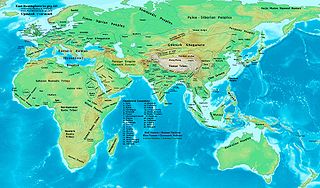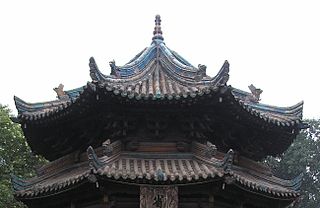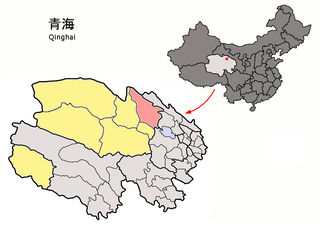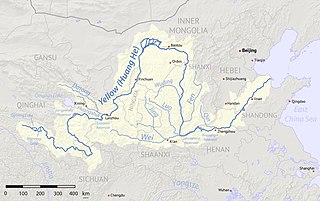
Qinghai, is a province of the People's Republic of China located in the northwest of the country. As one of the largest province-level administrative divisions of China by area, the province is ranked fourth-largest in area, and has the third-smallest population.

Xining is the capital of Qinghai province in western China, and the largest city on the Tibetan Plateau. It has 2,208,708 inhabitants at the 2010 census whom 1,198,304 live in the built up area made of 4 urban districts.

Xiahe is a county in Gannan Tibetan Autonomous Prefecture, Gansu province, the People's Republic of China, bordering Qinghai province to the west. It is home to the famed Labrang Tibetan Buddhist monastery, one of the largest Tibetan Buddhist monasteries outside the Tibet Autonomous Region. The town is populated largely by ethnic Tibetans, as well as some Hui and Han Chinese. The area is highly rural and pastoral. The geography is mountainous. In recent years it has become a tourist attraction. The town was named Xiahe in 1928.

Leymus is a genus of plants in the grass family Poaceae (Gramineae). It is widespread across Europe, Asia, and the Americas.
- Leymus aemulans - Xinjiang, Central Asia
- Leymus ajanensis - Siberia, Russian Far East, Alaska
- Leymus akmolinensis - Siberia, Kazakhstan, European Russia
- Leymus alaicus - Central Asia
- Leymus altus - Xinjiang
- Leymus ambiguus - mountains of western US
- Leymus angustus - Altai wild rye - China, Mongolia, Siberia, Central Asia
- Leymus arenarius - lyme grass - Europe
- Leymus aristiglumus - Qinghai
- Leymus × buriaticus - Siberia
- Leymus cappadocicus - Turkey, Afghanistan
- Leymus chinensis - China, Korea, Mongolia, Amur, Siberia
- Leymus cinereus - basin wild rye - western North America
- Leymus condensatus - giant wild rye - California, Baja California, Coahuila
- Leymus crassiusculus - Qinghai, Shanxi
- Leymus divaricatus - Kazakhstan
- Leymus duthiei - China, Korea, Japan, Nepal, northern India
- Leymus erianthus - Chile, Argentina
- Leymus × fedtschenkoi - Kyrgyzstan
- Leymus flavescens - Alberta, northwestern US
- Leymus flexilis - Kyrgyzstan, Kazakhstan
- Leymus flexus - Qinghai, Gansu, Shanxi
- Leymus innovatus - from Alaska + Northwest Territories to South Dakota + Ontario
- Leymus × jenisseiensis - Siberia
- Leymus karelinii - Xinjiang, Central Asia, European Russia
- Leymus komarovii - China, Mongolia, Korea, Russian Far East
- Leymus kopetdaghensis - Turkmenistan
- Leymus lanatus - Kyrgyzstan, Tajikistan, Afghanistan
- Leymus latiglumis - Uzbekistan
- Leymus leptostachyus - Qinghai, Xinjiang
- Leymus mollis - colder parts of Asia + North America
- Leymus multicaulis - European Russia, Central Asia, Xinjiang
- Leymus × multiflorus - California
- Leymus mundus - Tibet, Gansu
- Leymus nikitinii - Turkmenistan
- Leymus oblongolemmatus - Qinghai
- Leymus obvipodus - Qinghai
- Leymus ordensis - Siberia
- Leymus paboanus - Russia, China, Mongolia, Central Asia, Afghanistan
- Leymus pacificus - California
- Leymus paucispiculus - Qinghai, Gansu
- Leymus pendulus - Qinghai
- Leymus pishanicus - Xinjiang
- Leymus pluriflorus - Qinghai, Gansu
- Leymus pseudoracemosus - Qinghai
- Leymus pubinodis - Xinjiang
- Leymus racemosus - mammoth wild rye - Eurasia from Bulgaria to Mongolia
- Leymus × ramosoides - European Russia
- Leymus ramosus - Eurasia from Crimea to Mongolia
- Leymus ruoqiangensis - Xinjiang, Qinghai
- Leymus salinus - western US
- Leymus secalinus - Siberia, Mongolia, China, Korea, Central Asia, Himalayas
- Leymus shanxiensis - Shanxi
- Leymus sibiricus - Russia from Altai Krai to Magadan
- Leymus × sphacelatus - Tuva
- Leymus spiniformis - Qinghai, Shanxi
- Leymus tianschanicus - Iran, Central Asia, Xinjiang, Inner Mongolia
- Leymus triticoides - creeping wild rye - British Columbia, western US, Baja California, Tamaulipas
- Leymus × tuvinicus - Siberia
- Leymus × vancouverensis - British Columbia, Washington, Oregon, California
- Leymus villosissimus - Yakutia, Magadan, Kamchatka, Alaska, Yukon, Northwest Territories, British Columbia
- Leymus yiunensis - Xinjiang
Thitarodes is a genus of moths of the family Hepialidae. In English Thitarodes is known as "ghost moth". They are found in eastern Asia. The majority are restricted to the Tibetan Plateau. Often in Chinese entomological nomenclature Thitarodes is still referred to as Hepialus, although the name was changed back in 1968. Furthermore, some authors use incorrectly the term "bat moth" which is a bad translation of the Chinese term for ghost moth.

Tuyuhun was a powerful kingdom established by nomadic peoples related to the Xianbei in the Qilian Mountains and upper Yellow River valley.

Haidong is a prefecture-level city of Qinghai province in Western China. Its name literally means "east of the (Qinghai) Lake." On 8 February 2013 Haidong was upgraded from a prefecture (海东地区) into a prefecture-level city. Haidong is the second largest city in Qinghai after Xining.

The Kazakh exodus from Xinjiang occurred in waves during the 1950s and 1960s after the victory of the Communist Party of China in Xinjiang.

Kazakhs are a Turkic ethnic group, called Hāsàkè Zú in Chinese, and are among 56 ethnic groups officially recognized by the People's Republic of China.

Kobresia is a genus of plants in the sedge family. They are sometimes called bog sedges. These perennial sedges are quite similar to Carex species in appearance. The genus is widespread across much of Europe, Asia and North America, with many species native to the Himalayas.

The Longhai railway, formerly romanized as the Lunghai railway, is a major arterial east–west railway in China. It runs from Lianyungang, Jiangsu on the Yellow Sea to Lanzhou, Gansu through the provinces of Jiangsu, Anhui, Henan, Shaanxi, and Gansu, covering a total length of 1,759 kilometres. The line is named after Gansu, also known as Long (陇) in Chinese and Lianyungang's previous name, Haizhou. The Longhai Line is one of the busiest Chinese railways. It has dual tracks throughout the whole line, and the lines between Xuzhou, Jiangsu and Lanzhou, Gansu has been electrified.
Orontobia is a genus of tiger moths in the family Erebidae. The moths are found in the mountains of West China.
The Upper Mongols, also known as the Köke Nuur Mongols or Qinghai Mongols are ethnic Mongol people of Oirat and Khalkha origin who settled around Qinghai Lake in so-called Upper Mongolia. As part of the Khoshut Khanate of Tsaidam and the Koke Nuur they played a major role in Sino–Mongol–Tibetan politics during the 17th and 18th centuries. The Upper Mongols adopted Tibetan dress and jewelry despite still living in the traditional Mongolian ger and writing in the script.
Littledalea is a genus of Asian plants in the grass family, native to mountains in China and neighboring countries. The genus is placed in its own tribe Littledaleae within subfamily Pooideae. The isolated tribe seems to be sister to the tribes Bromeae and Triticeae.

Tianjun County is a county of Qinghai Province, China, bordering Gansu Province to the north. It is under the administration of the Haixi Mongol and Tibetan Autonomous Prefecture. The county seat in Xinyuan Town (新源镇).
Soroseris is a genus of Asian plants in the dandelion tribe within the daisy family.
- Soroseris depressa(Hook. f. & Thomson) J.W. Zhang, N. Kilian & H. Sun - Tibet, Bhutan, Sikkim, Nepal
- Soroseris erysimoides(Hand.-Mazz.) C.Shih - Gansu, Qinghai, Shaanxi, Sichuan, Tibet, Yunnan, Bhutan, Sikkim, Nepal
- Soroseris glomerata(Decne.) Stebbins - Gansu, Qinghai, Sichuan, Xinjiang, Tibet, Yunnan, Kashmir, Nepal, Uttarakhand, Pakistan
- Soroseris hookeriana(C.B.Clarke) Stebbins - Gansu, Qinghai, Sichuan, Tibet, Yunnan, Bhutan, Uttarakhand, Nepal
- Soroseris pumilaStebbins - Tibet, Bhutan, Sikkim
- Soroseris teresC.Shih - Tibet, Bhutan
- Soroseris umbrella(Franch.) Stebbins - Sichuan, Tibet, Yunnan, Bhutan, Sikkim

The Beijing-Tibet Expressway, commonly abbreviated to Jingzang Expressway, also known as Beijing-Lhasa Expressway or China National Expressway 6, is part of the Chinese national expressway network and is planned to connect the nation's capital, Beijing, to the capital of the Tibet Autonomous Region, Lhasa.
Neolithic Tibet refers to a prehistoric period in which Neolithic technology was present in Tibet.
Hao Peng is a politician and business executive of the People's Republic of China, currently serving as the Party Committee Secretary of the State-owned Assets Supervision and Administration Commission (SASAC). He served as the Governor of Qinghai province between 2013 and 2016, and prior to that, a Vice Chairman of Tibet Autonomous Region.

The Huangshui River or Huang Shui is a river in Qinghai and Gansu, China. The river is a left tributary of the Yellow River and its total length is 374 km (232 mi) with a basin area of 3,200 km2 (1,200 sq mi).














